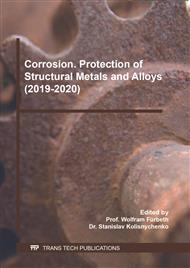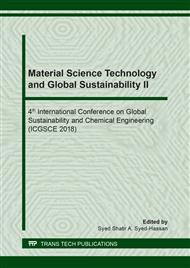[1]
Koch, G.H., Brongers, M.P., Thompson, N.G., Virmani, Y.P. and Payer, J.H., (2002). Corrosion cost and preventive strategies in the United States, (No. FHWA-RD-01-156,).
Google Scholar
[2]
Nnanna, L. A., Anozie, I. U., Avoaja, A. G. I., Akoma. C. S., and Eti, E. P. (2011). Comparative study of corrosion inhibition of aluminium alloy of type AA3003 in acidic and alkaline media by Euphorbia hirta extract. African Journal of Pure and Applied Chemistry. 5(8), 265-271.
Google Scholar
[3]
Raja, P. B., and Sethuraman, M. G. (2008). Natural products as corrosion inhibitor for metals in corrosive media—a review. materials letters, 62(1), 113-116.
DOI: 10.1016/j.matlet.2007.04.079
Google Scholar
[4]
Soror, T. Y. (2013). Saffron extracts as environmentally safe corrosion inhibitors for aluminium dissolution in 2M HCl Solution. Eur. Chem. Bull. 2(4), 191-196.
Google Scholar
[5]
Akalezi, C.O., and Oguzie, E.E. (2015). Evaluation of anticorrosion properties of Chrysophyllum albidum leaves extract for mild steel protection in acidic media. International Journal of Industrial Chemistry, 7(1), 81-92.
DOI: 10.1007/s40090-015-0057-5
Google Scholar
[6]
Patni, N., Agarwal, S., and Shah, P. (2013). Greener approach towards corrosion inhibition. Hindawi Publishing Corporation Chinese Journal of Engineering (2013).
DOI: 10.1155/2013/784186
Google Scholar
[7]
Mohd, N., and Ishak, A. S. (2015). Thermodynamic study of corrosion inhibition of mild steel in corrosive medium by piper Nigrum extract. Indian Journal of Science and Technology, 8(17), 1.
DOI: 10.17485/ijst/2015/v8i17/63478
Google Scholar
[8]
Muthumanickam, S., Jeyaprabha, B., Karthik, R., Elangovan, A., & Prakash, P. (2015). Adsorption and corrosion inhibiting behavior of Passiflora foetida leaf extract on mild steel corrosion. Int. J. Corros. Scale Inhib, 4(4), 365-381.
DOI: 10.17675/2305-6894-2015-4-4-6
Google Scholar
[9]
de Souza, F. S., and Spinelli, A. (2009). Caffeic acid as a green corrosion inhibitor for mild steel. Corrosion Science, 51(3), 642-649.
DOI: 10.1016/j.corsci.2008.12.013
Google Scholar
[10]
Eddy, N.O. and Ebenso, E.E (2008). Adsorption and inhibitive properties of ethanol extracts of Musa sapientum peels as a green corrosion inhibitor for mild steel in H2SO4. Afr J Pure Appl Chem, 2(6), 046-54.
Google Scholar
[11]
Gunavathy, N., & Murugavel, S. C. (2013). Corrosion inhibition study of bract extract of Musa acuminatainflorescence on mild steel in hydrochloric acid medium. IOSR Journal of applied chemistry, 5(2), 29-35.
DOI: 10.9790/5736-0522935
Google Scholar
[12]
Waghmare, J. S., and Kurhade, A. H. (2014). GC-MS analysis of bioactive components from banana peel (Musa sapientum peel).European Journal of Experimental Biology. 4(5), 10-15.
Google Scholar
[13]
Mordi, R. C., Fadiaro, A. E., Owoeye, T. F., Olanrewaju, I. O., Uzoamaka, G. C., and Olorunshola, S. J. (2016). Identification by GC-MS of the Components of Oils of Banana Peels Extract, Phytochemical and Antimicrobial Analyses. Research Journal of Phytochemistry 10(1), 39-44, (2016).
DOI: 10.3923/rjphyto.2016.39.44
Google Scholar
[14]
ASTM. (1990). Standard Practice for Preparing, Cleaning, and Evaluating Corrosion Test Specimens ASTM Designation: G1 – 90 (Reapproved 1999) (Vol. 03.02, p.8): ASTM International.
Google Scholar
[15]
Nair, R. N., Sharma, S., Sharma, I. K., Verma, P. S., and Sharma, A. (2010). Inhibitory efficacy of Piper Nigrum Linn. extract on corrosion of AA1100 in HCl. 3(4), 783-795.
Google Scholar
[16]
Gunavathy, N., and Murugavel, S. C. (2014). Musa acuminata bract extract as corrosion inhibitor for mild steel. Chem Sci Rev Lett, 3(11S), 70-79.
Google Scholar
[17]
Matheswaran, P., & Ramasamy, A. K. (2012). Corrosion inhibition of mild steel in citric acid by aqueous extract of Piper Nigrum L. Journal of Chemistry, 9(1), 75-78.
DOI: 10.1155/2012/803098
Google Scholar
[18]
El-Maksoud, S. A. (2008). The effect of organic compounds on the electrochemical behaviour of steel in acidic media. A review. International Journal of Electrochemical Science, 3(5), 528-555.
Google Scholar
[19]
Singh, A., Singh, V. K., & Quraishi, M. A. (2013). Inhibition of mild steel corrosion in HCl solution using Pipali (Piper longum) fruit extract. Arabian Journal for Science and Engineering, 38(1), 85-97.
DOI: 10.1007/s13369-012-0409-9
Google Scholar
[20]
Sharma, A., Choudhary, G., Sharma, A., & Yadav, S. (2013). Effect of temperature on inhibitory efficacy of Azadirachta indica fruit on acid corrosion of aluminum. International Journal of Innovative Research in Science Engineering and Technology, 2(12), 7982-7992.
Google Scholar
[21]
Ehiowemwenguan, G., Emeghene, A. O., and Inetianbor, J. E. (2014). Antibacterial and Phytochemical Analysis of Banana Fruit Peel. IOSR Journal of Pharmacy. Vol. 4, Issue 8, pp.18-25.
Google Scholar
[22]
Velumani, S. (2016). Phytochemical screening and antioxidant activity of banana peel. International Journal of Advance Research and Innovative Ideas in Education. 2(1).
Google Scholar
[23]
Andreani, S., Znini, M., Paolini, J., Majidi, L., Hammouti, B., Costa, J., & Muselli, A. (2016). Study of corrosion inhibition for mild steel in hydrochloric acid solution by Limbarda Crithmoides (L.) Essential Oil of Corsica. J. Mater. Environ. Sci, 7(1), 187-195.
DOI: 10.1002/cbdv.201300109
Google Scholar
[24]
Prakash, R. (2012). Green Capsicum annuum fruit extract for inhibition of mild steel corrosion in hydrochloric acid solution. Int J Electrochem Sci, 7, 12146-12158.
Google Scholar
[25]
Loto, R. T., Loto, C. A., Joseph, O., and Olanrewaju, G. (2016). Adsorption and corrosion inhibition properties of thiocarbanilide on the electrochemical behavior of high carbon steel in dilute acid solutions. 305-314.
DOI: 10.1016/j.rinp.2016.05.013
Google Scholar
[26]
Gunavathy, N., & Murugavel, S. C. (2012). Corrosion inhibition studies of mild steel in acid medium using Musa acuminata fruit peel extract. Journal of Chemistry, 9(1), 487-495.
DOI: 10.1155/2012/952402
Google Scholar
[27]
Kairi, N. I., & Kassim, J. (2013). The effect of temperature on the corrosion inhibition of mild steel in 1 M HCl solution by Curcuma longa extract. Int J Electrochem Sci, 8, 7138-7155.
Google Scholar
[28]
Hashim, N. Z. N., & Kassim, K. (2014). The effect of temperature on mild steel corrosion in 1 M HCl by schiff bases. The Malaysian Journal of Analytical Sciences, 18(1), 28-36.
Google Scholar



